Your Night Sky for June 17, 2020

Our Moon
The official start of summer is coming up on the 20th of June, which is the longest day of the year. Then days will begin to get shorter, but it will be a while before we notice that. On the 21st the new moon will occur. So if you like to stay up late or get up early, this is a good time to look at the dark sky.
Our moon is the most prominent night time object in our sky. Even though it's only ¼ the size of Earth, it's the 5th largest planetary satellite in our solar system. The only brighter object in our sky is the Sun. Twelve astronauts have walked on the moon and brought back rocks. I remember watching them do that on TV. When I briefly lived in Florida, I was able to watch one of their launches. That was amazing!
Because our planet is tilted a little, the moon doesn't orbit the equator. It's locked to Earth in Synchronous spin which means it makes one spin on its axis the same time it makes one orbit of Earth. So the same side of the moon always faces us. Its gravity influences our oceans which creates the waves. Only 2 of Neptune's moons do not orbit in the planets equator. Other than that, all other moons in our solar system orbit the planets equator.
Like the Sun it rises in the east and sets in the west. It has an elliptical orbit around us, so its distance from us varies. Perigee is when it's closest making it faster, and apogee is when it's farthest making it slower. That creates a 10 percent change in distance from us. Its orbit takes 27.32 days, and with its slight 6.7 percent tilt like Earth's tilt, we can occasionally see about 18 percent of its far side.
The moon is heavily cratered from the impact of asteroids and meteoroids (space rocks). About 4.5 billion years ago there was a collision between young Earth and an object about the size of Mars. The impact spewed out a huge amount of rocky debris which eventually coalesced to form the moon. Even though it's small, the core consists of an outer part of molten iron around a solid iron rich inner part.
It's a cold dry lifeless ball of rock with an insubstantial atmosphere that shines by reflecting light from our Sun. Its thin atmosphere changes the temperature from as low as -274 degrees F at night, and as high as 257 degrees F during the day. Its gravity is only 1/6 of Earth's. Its cycle starts with a New Moon that's not visible because the Sun is behind it, Waxing Crescent, first quarter, Waxing Gibbous, Full Moon when it's on the opposite side of Earth from the Sun, Waning Gibbous, third quarter, Waning Crescent and back to New Moon.
There are mountains, impact craters and smooth surfaces. Some craters are small and some are big. The largest mountain is Mons Huygens at about 18,000 feet. The crater valleys are up to 100 miles long and 6 miles wide. Brighter areas are called highlands, and darker areas are called the seas. Highlands are older mountain peaks and craters. Seas are remains of craters. The ray craters are the most obvious features. They were formed when impacting objects sent out splashes of molten rock as they hit the surface.
The best time to look at the moon is a few days before or after the full moon, because the Sun makes the full moon too bright to observe a lot of details. You'll see a lot with unaided vision, but obviously binoculars will give you more to observe. So, since the new moon is on the 20th, give it a few days before you start examining it.



